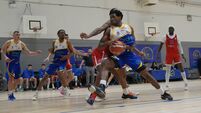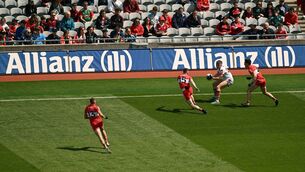Another box ticked en route to Cork double

So John Horan will hardly countenance splitting Dublin, but he is happy to divide Cork.
They have taken exception, on Leeside, to the GAA president’s suggestion that it is two ‘different cohorts’ of Cork supporter interested in this weekend’s matches.
Since the fixtures were announced, we have been treated to a revival of that great noughties tradition of Cork people bemoaning the hassle and grief and cost of going to a match every week.
While Eddie Hobbs would lecture the nation about fiscal husbandry, his brethren would detail, at great length, just how much it was costing them to go to all these All-Ireland quarter-finals and semi-finals and finals.
Those good times ended, for Eddie and his brethren, but now they are back.
And whatever the reality of the situation, a Dub trying to divide them, while organising everything to suit themselves, is the swiftest known means of uniting all Rebel interests.
Which suggests again, to me, what has been increasingly obvious for a good while now: Cork are going to do the double again next year, on the 30th anniversary, and all the pieces are gradually falling into place.
The only lingering question now is whether they win one or both of them this year, too, to jump the gun slightly.
A small miscalculation, having failed to take into account the sheer potency of Corkness.
I notice that Cork’s own Adrian Russell is bringing out his book on the original double this September, just in case.
They can smell it alright.
Puncturing fantasy football
It is a rare event, like a total eclipse, but briefly there is satisfaction with Gaelic football.
Kieran Shannon is looking forward to a few weeks of ‘fantasy football’ in the Super 8s. Tommy Martin has ruled that the game has somehow ‘healed itself’.
Every now and again there are these moments of clarity, when the sport makes perfect sense, as if David Clifford has just taken the ball into his hands.
It never lasts, needless to say, and by Monday or Tuesday we will doubtless have returned to agonising over ways to solve the pulling and dragging and rooting and tearing, and struggling to devise some magical ‘structure’ to fix all the problems.
No doubt the ‘Gah’s’ temporary sense of enormous well-being has been deepened by an unexpected outpouring of the very thing that satisfies us most: Johnny Foreigner telling us we are great altogether.
Mayo’s James Carr had eight million views of his wonder goal against Galway, when they stopped counting. The @futbolbible Twitter account was among those to get the ball rolling, deciding Carr’s weaving run and finish was the “perfect mix of Messi, Ronaldo, and LeBron”.
By the time it had landed on ESPN Argentina, many Irish people had distinguished themselves by marauding giddily around the internet, as though a visiting Late Late Show superstar had confirmed they were enjoying their stay.
These digital ambassadors had two key messages to deliver to semi-interested international observers: The players aren’t paid; And wait ’til you see hurling.
But there are two issues, alas, with Carr’s viral sensation. For starters, there is the GAA’s persistent tolerance for stanchions. The aesthetics of what should have been a net-bulger were certainly marred by it rebounding out of the Gaelic Grounds goal. And probably meant there was at least a 25% risk of the umpires waving play on.
But it didn’t take long for Johnny Foreigner to raise a more fundamental issue.
Indeed, in the very first reply to @futbolbible, a South African gentleman posed the reasonable question about Carr’s long-distance run: “How do they win the ball back?”
And so, a conversation around a magical Gah moment quickly dissolved into a puzzled debate about the tackle and the rules.
Business as usual.
A two-tier structure in battle for hearts and minds
There is irony, all the same, that the most-watched GAA moment in a long time came from a match broadcast live on Sky Sports. Even if it was the GAA’s own social media platforms that circulated the clip of Carr’s goal.
The eight million views make a decent case for ICC chief executive David Richardson’s argument, defending the decision to sell Sky Sports exclusive rights to the Cricket World Cup.
“We make sure we are pushing highlights out through the BBC and our own channels plus YouTube, Twitter and Facebook, which is successful, especially when you are trying to attract younger people. They are not necessarily following the games on television.”
Richardson was batting away the accusation that cricket has missed a pivotal chance to arrest the game’s slide to the margins of English consciousness, just as women’s football seized its moment — 1.78m watched England’s World Cup win over India compared to the 11.7m who watched the women’s World Cup defeat by USA.
Sky has since bowed to pressure and will allow tomorrow’s final be screened on Channel 4 too, now England are there.
And even if sporting administrators are content to write off the attention span of a generation and allow highlights clips take their chances in the battle for attention with cat videos and Love Island memes, perhaps the TV companies themselves may need a better plan if they are to protect the business models they have thrown so much money at.
So, how about more free broadcasts, to capture hearts and minds, perhaps in bog standard, two-camera mode? Alongside premium, Ultra HD services, with all the added angles and stats and punditry the committed sports fan wants?
Or, since this is a week when the Gah is showing the way — a two-tier structure.










